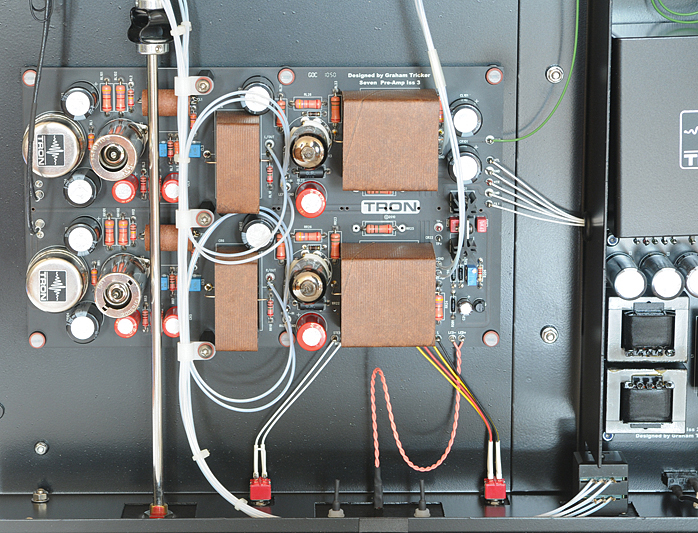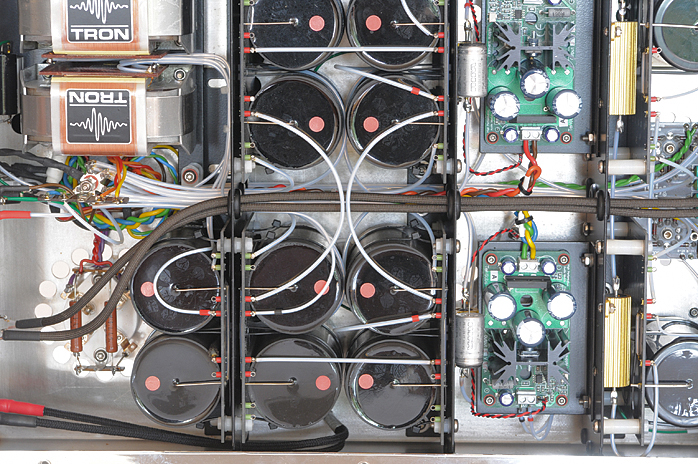This review page is supported in part by the sponsors whose ad banners are displayed below |
 |
 |
In the battle against interference from any source and to keep the preamp as quiet as humanly possible, the Seven uses an aluminum case. Inside a steel divider separates power supply from delicate signal circuitry. More separation comes from the rubber-mounted steel-encapsulated mains transformer. To keep the whole circuit as simple a possible Graham only runs two 12AX7 dual triodes for RIAA stage and two 5687 dual triodes for voltage gain and current output. Once the signal exits the MC cartridge, it gets amplified by two custom stepup transformers. These have a gain of 20dB to net a total of 68dB at the outputs. 26dB and any custom gain setting up to +40dB are available however. Upon special request the Seven can also be suited to MM cartridges. The RIAA correction employs passive filtering where the filter components are hand-matched for best result. In the constant battle against spurious noise the circuit boards float from the chassis. A very nice detail is the universal joint used in the shaft connecting input selector knob with Elna selector switch to assure a smooth switching.
|
 |
Our three audio manufacturers had never listened to the Pnoe horns before and we gave them a good time with the PS Audio PerfectWave transport as digital source, Blackbird turntable with Zu cartridge for analog material and the Devialet D-Premier all-in-one miracle system. In turn we learned from Graham’s music library and discovered Concha Buika and Rupa & the April Fishes. The first proved to be a literal tear jerker in the best audiophile sense of the word. After Graham, Paul and Hans left we were alone with both Trons and had to decide which pair of speakers would run the gauntlet first. For starters the above setup was used without the Devialet.
|
|
|
Switching from a class A/D hybrid with all discrete components to a 300B SET is big. It is a step in history from 21st century digital ingenuity to 20th century analog tube contrivance but otherwise not a backward step at all. For digital we had to add a the PerfectWave DAC of course as the D-Premier’s built-in one had been removed. This meant two sets of additional signal cables and an extra power cable. In fact only the source, software and loudspeaker were the same. A comparison of both systems thus was apples and oranges. Nevertheless each had its own signature and merits. In our view the class A-D hybrid all-in-one D-Premier was the powerhouse. With its 120wpc into the 16-ohm Pnoe horns it really played the large room and created a wide and deep virtual stage. With the puppy paper power of 8 watts the Discovery would have seemed to be severely handicapped but this proved very much untrue.
|
 |
Dutch tube guru Peter van Willenswaard a decade ago wrote two interesting articles on the differences between output watts and perceived loudness in relation to transistor and tube amplifiers for Stereophile. In them he described subjective loudness of both technologies and provided measurements with astonishing results. Peter measured a real-load loudspeaker rather than static 8-ohm resistor where an 8-watt 300B SET output 30V peaks as the equivalent of a 50wpc transistor amplifier whilst the static dummy load only measured values up to 14V peak. Peter conducted further experiments and his conclusion was that tubes are louder. One could argue that they clip more gently which is valid. But how about the presence of output transformers? We have never yet noticed the D-Premier or Tron clip—never say never—yet there is a completely different perception of loudness when listening to the Tron/Pnoe versus Devialet/Pnoe combination.
|
 |
Finding the correct volume setting for any 100dB load can be tough when the Noble volume control had to operate over the first 50° before things got too loud. Graham offers a shallower volume taper option to delay the onset of gain for such cases. We already mentioned how the teensy-weensy 8 watts could get far too loud whereas the comparatively monster power of 120 watts could be tapped substantially before achieving overload. In our opinion the culprit is that when the musical signal remains perfectly clean one can keep pushing the volume. When the musical signal is inherently warmer, overload kicks in a lot sooner. ‘Warmer’ here refers not to apparent distortion but the signature of tube amplifiers especially of the 300B DHT variety. It’s what makes these kind of amplifier so likeable, natural, embodied and analogue.
|
|
|
And yes the Tron Discovery is a very likeable if typical 300B SET amplifier where the difference to others in the same league works out to being quieter and truer to the source. The Discovery does not imprint itself on the music. Like all others there is a Midrange with a capital ‘M’ which defines the sound to envelop the listener and warm her from inside. With the Seven/Discovery combination this Midrange also caused a soundstage illusion with the Pnoe horns and appropriate recording that was deeper than with the D-Premier and more densely peopled. It seemed as though someone lit tea candles in the farthest corners of the stage. Artifact or not, the presence of this additional lighting was perceived as pleasing and involving.
|
 |
Next on hand was a tandem combination of even higher-sensitivity hornspeakers. Not single widebander designs, the Avantgarde Duo Omega uses four drivers, two crossover circuits and a built-in amplifier for the 170Hz-down sealed woofers. Their front-loaded horns make the sound more forward and in your face than the backloaded Pnoe. As a result the musical performance for the greater part takes place between the speaker’s front pane and listener. Next to being 7dB more sensitive than the Pnoe, this more forward character amplifies every iota of HF noise. From source to last cable every component must be the quietest available to make listening to the Duo enjoyable. Just like the cougher in the concert hall, apparent hiss draws too much attention away from what it’s all about in the first place.
|
 |
  |
 |